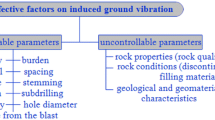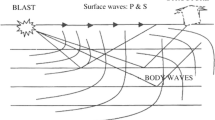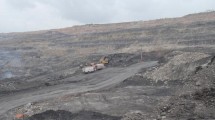Abstract
The purpose of this article is to evaluate and predict blast-induced ground vibration at Shur River Dam in Iran using different empirical vibration predictors and artificial neural network (ANN) model. Ground vibration is a seismic wave that spreads out from the blasthole when explosive charge is detonated in a confined manner. Ground vibrations were recorded and monitored in and around the Shur River Dam, Iran, at different vulnerable and strategic locations. A total of 20 blast vibration records were monitored, out of which 16 data sets were used for training of the ANN model as well as determining site constants of various vibration predictors. The rest of the 4 blast vibration data sets were used for the validation and comparison of the result of ANN and different empirical predictors. Performances of the different predictor models were assessed using standard statistical evaluation criteria. Finally, it was found that the ANN model is more accurate as compared to the various empirical models available. As such, a high conformity (R 2 = 0.927) was observed between the measured and predicted peak particle velocity by the developed ANN model.











Similar content being viewed by others
References
Duvall WI, Johnson CF, Meyer AVC (1963) Vibrations from instantaneous and millisecond delay quarry blasts. RI. 6151. US, Bureau of Mines, United States Department of Interior, Washington
Nicholls HR, Johnson CF, Duvall WI (1971) Blasting vibrations and their effects on structures. Bulletin Washington, DC, Bureau of Mines, no. 656
Siskind DE, Crum SV, Otterness RE, Kopp JW (1989) Comparative study of blasting vibrations from Indiana surface coal mines. RI 9226, USBM
Elseman I, Rasoul A (2000) Measurement and analysis of the effect of ground vibration induced by blasting at the limestone quarries of the Egyptian cement company. Cairo University, Egypt
Khandelwal M, Singh TN (2009) Prediction of blast induced ground vibration using artificial neural network. Int J Rock Mech Min Sci 46:1214–1222
Khandelwal M, Singh TN (2007) Evaluation of blast induced ground vibration predictors. Soil Dyn Earthq Eng 27:116–125
Mostafa TM (2009) Artificial neural network for prediction and control of blasting vibrations in Assiut (Egypt) limestone quarry. Int J Rock Mech Min Sci 46(2):426–431
Duvall WI, Fogelson DE (1962) Review of criteria for estimating damages to residences from blasting vibrations. R. I. 5968, US, Bureau of Mines
Ambraseys NR, Hendron AJ (1968) Dynamic behaviour of rock masses rock mechanics in engineering, practices. Wiley, London
Davies B, Farmer IW, Attewell PB (1964) Ground vibrations from shallow sub-surface blasts, vol 217. The Engineer, London, pp 553–559
Indian Standards Institute (1973) Criteria for safety and design of structures subjected to underground blast. ISI Bull, IS-6922
Roy PP (1991) Prediction and control of ground vibrations due to blasting. Colliery Gaurdian, 239
Khandelwal M, Singh TN (2005) Prediction of blast induced air overpressure in opencast mine. Noise Vib Worldwide 36:7–16
Rajasekaran S, Pai GAV (2005) Neural networks, fuzzy logic and genetic algorithms: synthesis and applications. Prentice Hall, New Delhi
Monjezi M, Dehghani H (2008) Evaluation of effect of blasting pattern parameters on back break using neural networks. Int J Rock Mech Min Sci 45:1446–1453
Monjezi M, Ahmadi M, Sheikhan M, Bahrami A, Salimi AR (2010) Predicting blast-induced ground vibration using various types of neural networks. Soil Dyn Earthq Eng 30:1233–1236
Monjezi M, Ghafurikalajahi M, Bahrami A (2011) Prediction of blast-induced ground vibration using artificial neural networks. Tunn Undergr Space Technol 26:46–50
Monjezi M, Singh TN, Khandelwal M, Sinha S, Singh V, Hosseini I (2006) Prediction and analysis of blast parameters using artificial neural network. Noise Vib Worldwide UK 37(5):8–16
Rogers SJ, Chen HC, Kopaska-Merkel DC, Fang JH (1995) Predicting permeability from porosity using artificial neural networks. AAPG 79:1786–1797
Author information
Authors and Affiliations
Corresponding author
Rights and permissions
About this article
Cite this article
Monjezi, M., Hasanipanah, M. & Khandelwal, M. Evaluation and prediction of blast-induced ground vibration at Shur River Dam, Iran, by artificial neural network. Neural Comput & Applic 22, 1637–1643 (2013). https://doi.org/10.1007/s00521-012-0856-y
Received:
Accepted:
Published:
Issue Date:
DOI: https://doi.org/10.1007/s00521-012-0856-y




